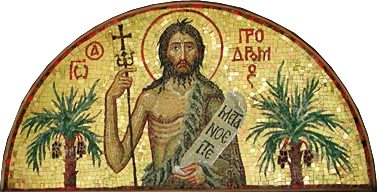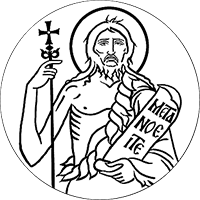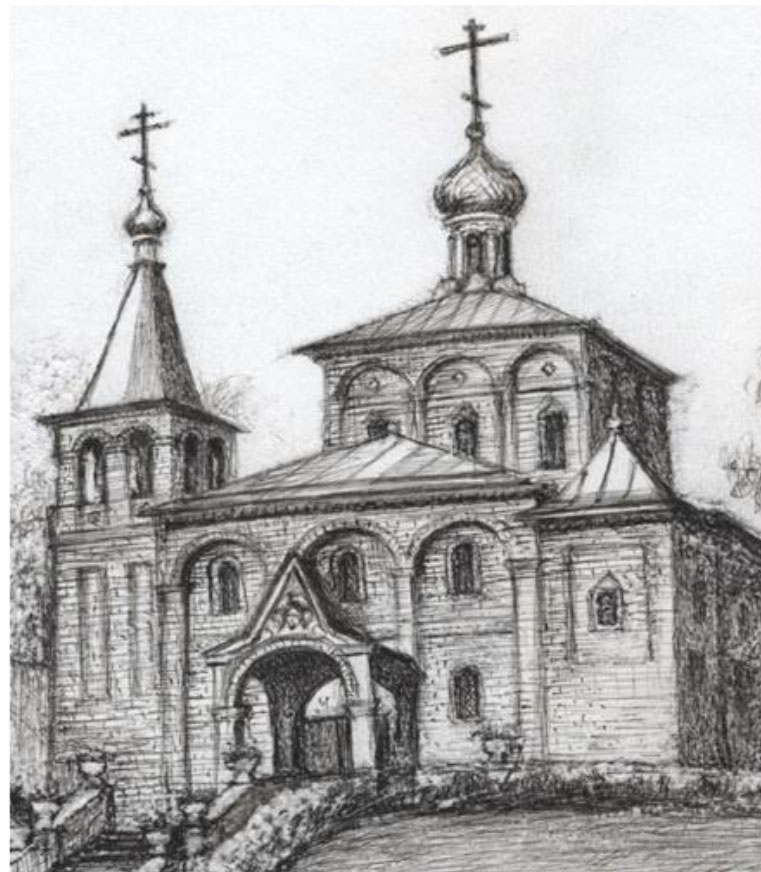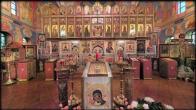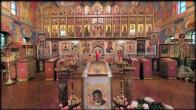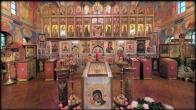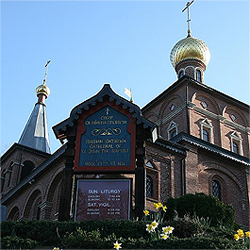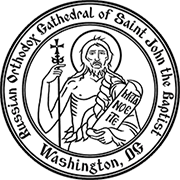You are here
The Circumcision of Our Lord Jesus Christ
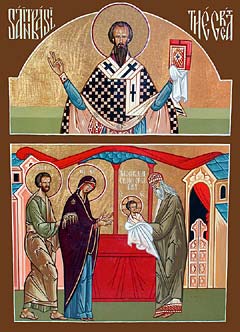
And when eight days were accomplished for the circumcising of the child, his name was called JESUS, which was so named of the angel before he was conceived in the womb. Luke 2, 21
Troparion
Thou Who sittest with the Father on a fiery throne in the heights wast pleased to be born of a Virgin through the Divine Spirit on earth. Wherefore Thou wast circumcised as a man on the eighth day. Glory to Thine all-gracious will; glory to Thy providence; glory to Thy condescension, O only Lover of mankind.
Circumcision of Jesus Christ. Top - St.Basil the Great
St. Basil the Great, archbishop of Caesarea in Cappadocia - Universal Teacher
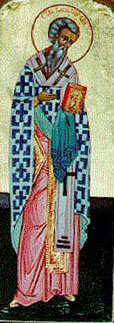 Hierarch Basil the Great is one of the Church's most remarkable theologians. His influence on the fortunes of the Church spread far beyond the borders of his homeland and is felt till our days. To the pen of Saint Basil the Great belong commentaries on Sacred Scripture, a treatise on the Holy Spirit, epistles, sermons and rules for monastic life
Hierarch Basil the Great is one of the Church's most remarkable theologians. His influence on the fortunes of the Church spread far beyond the borders of his homeland and is felt till our days. To the pen of Saint Basil the Great belong commentaries on Sacred Scripture, a treatise on the Holy Spirit, epistles, sermons and rules for monastic life
1 He did very much for the establishment of the order of the Liturgy, 2 and numerous prayers were written by him. The Church reveres him as a fighter for the purity of the faith, a great hierarch and theologian, calling him a "universal teacher". Only on two other saints John Chrysostom and Gregory the Theologian is such a great honor bestowed. 3 Basil the Great was a man of encyclopedic cast. A philosopher, philologist, orator, jurist, scientist, archaeologist, who possessed profound knowledge in astronomy, mathematics and medicine "he was a ship, loaded with as much erudition as human nature can contain", writes his contemporary, Saint Amphilochius, Bishop of Iconium. 4 Hierarch Basil the Great was born about the year 329 in the Asia Minor city of Ceasarea, the administrative center of Cappadocia, into a rich and notable family, which had given not a few righteous to be numbered among the choir of the saints. Basil's mother, Emilia, was the daughter of a martyr, who had suffered at the time of Diocletian's persecutions, while his grandfather on his father's side had hid in the thick forests of Pontus with his whole family during the course of seven years.
In the family of Basil the Great's parents were ten children five sons (one died in early childhood) and five daughters; of them, five were subsequently numbered among the choir of the saints: Basil himself, Macrina, 5 Gregory, subsequently bishop of Nyssa, 6 Peter, at first a simple ascetic and afterwards bishop of Sebaste, 7 and the righteous Theosebia, a deaconess. 8 The future hierarch received a primary education in the midst of the pious and ascetically inclined women of his family. His father, Basil the Elder a lawyer and teacher of rhetoric was himself engaged in his education. He received a secondary education from the best teachers in Ceasarea of Cappadocia, and later transferred to the schools of Constantinople, where he listened to prominent orators and philosophers. For the completion of his education, Saint Basil set off for Athens the center of classical enlightenment. Here he passed four years, studying, in particular, the philosophy of Plato, which exerted a certain influence on his worldview and theological constructs. In Athens, a close friendship between Basil the Great and Gregory the Theologian 9 began. According to the words of the latter, they became everything for each other: comrades and tablecompanions and kindred, "having one aim", said Gregory the Theologian, "we constantly grew in love for one another…Only two roads were known to us: one to our sacred churches and to the teachers there; the other to our instructors in the external sciences". Already in Athens, the friends gave their word to each other to enter the life of the Christian ascetics together. Saint Gregory the Theologian remarks that upon returning to his homeland, Basil the Great was not distinguished by a height of Christian inclination. However, under the influence of his energetic sister, Macrina, he quickly overcame the temptations of youth and resolved to dedicate himself to the contemplative life.
In the year 355, Basil the Great was baptized and after two years undertook a journey to the Christian Near East, to the great Orthodox ascetics. The renowned ascetics struck him so much that upon returning home to Cappadocia, he resolved to imitate them. Having distributed the greater part of his property to the poor, Saint Basil drew a group of those seeking the monastic life to a picturesque locale on the banks of the Iris River and began to call thither his friend, Gregory the Theologian. However, responsibilities in regard to his aged parents hindered Gregory from realizing his youthful dream of joint asceticism with his friend. All the same, at times he would visit Basil the Great's monastic community, where the friends would struggle in conditions of scarcity and in strict abstinence. Saints Basil and Gregory were intensely occupied with the study of Sacred Scripture under the direction of the ancient commentators, in particular, Origen,10 from whose works they compiled the collection, "Philocalia" (which has nothing in common with the presentday ascetical anthology bearing the same name). At that same time, Basil the Great, at the request of the monks, wrote a collection of the rules of moral life.
By his example and sermons, Hierarch Basil the Great promoted the spiritual perfecting of the Christians of his homeland and many sought him out. Men's and women's monasteries were formed, in which Basil the great introduced a mixed form of the monastic life coenobitic and eremitic free from extremes. Prayer and contemplation in his monasteries alternated with physical labor, while only such trades were allowed which did not violate the spiritual collectedness and simplicity of the monastic life. Other distinguishing features and even innovations in the monastic way of life, according to the rule of Basil the Great, were broad charitable activity and the education of children of both sexes.
In the year 360, Basil the Great, while being still only a reader, was present at a Constantinopolitan council, and in 364 was ordained a priest in Caesarea. He preached twice a day and carried on a struggle with the enemies of Orthodoxy. He did much for the inhabitants of his native city during a terrible famine. Upon becoming archbishop, Basil continued to lead a strict ascetic life, would visit the poor, the sick and the lepers and founded a hospice the size of a small town. Saint Gregory the Theologian describes Basil the Great's appearance: a wellproportioned figure, a full, light brown beard, a slow gait, the absence of haste in movements and speech, inner concentration. Everything in him evoked esteem and even his adversaries would bow before him.
The fourth century, in which Basil the Great's activity passed, was a remarkable, golden age of patristic literature and, at the same time, a tragic period in the history of the Church. Heresies appeared one after another Arianism, Appolinarianism, Nestorianism, Eutycianism bringing disturbance and instability into the enclosure of the Church, undermining her authority and the faith in the hearts of the weak. The most dangerous of the heresies was Arianism. The Arians adhered to the false teaching according to which the Son of God was not eternal, did not exist before birth, was not beginningless and, therefore, not of one essence with God the Father. Saint Basil wrote three books against the Arians.
In the year 370, Saint Basil was elevated to the Caesarean episcopal cathedra. Fifty bishops in eleven provinces were subordinate to him. Amidst constant dangers, Saint Basil supported the Orthodox and made steadfast their faith, summoning them to manliness and patience. Numerous letters were written by him to Churches, bishops, clergy and private persons. In the struggle with the heretics, Saint Basil all his life provoked hostility and all possible intrigues from the Arians.
In the year 372, Saint Basil came out openly against the teaching of Eustathius of Sebaste, 11 with whom till that time he was on friendly terms. He demanded of him an Orthodox confession of faith, and when he refused, broke off liturgical communion with him. In the dispute on the Holy Spirit, Saint Basil was supported by Athanasius the Great, 12 but all his attempts to receive spiritual help in Rome proved to be in vain: the East and the West already then did not understand each other on the question of the Holy Spirit. Although they still were confessing the same teaching, yet they spoke in different languages and used different terms.
The Emperor Valens (364378), a resolute supporter of the Arians, who unsparingly dispatched bishops displeasing to him into exile and planted Arianism in other Asia Minor provinces, came to Cappadocia with the same aim. He sent the Prefect Modestus to Basil in order to convince the hierarch to join the Arians. Modestus threatened him with ruin, exile, tortures and even the death penalty. Saint Gregory tells Basil the Great's response:
"Thou threatenest me with the confiscation of property, but it means nothing for the man who possesses nothing, unless thou desirest to receive this modest clothing and a few books which make up all my estate. Exile? but I do not know it, since I am not limited by space. If this ground on which I stand right now does not belong to me, then the whole earth belongs to God, Whose temporary guest I am. Torments? but they do not have power over one not having flesh, except perhaps for the first blow, which thou art free to make. Death? but it will be deliverance for me, since it will quickly bring me to God, for Whom I live and to a greater extent have died, and to Whom I hasten to come…Tell the Emperor that neither violence nor persuasion will force me to accept a wrong teaching". Modestus was struck by these words. Having informed Valens of Saint Basil's inexorableness, the Prefect added: "We are vanquished, O Emperor, by the leader of the Church." Basil the Great displayed the same steadfastness also before the face of the Emperor himself, and by his behavior and staunchness made such an impression on Valens that he did not support the Arians who had demanded the banishment of Basil. Hierarch Gregory Nazianzen tells about this as follows:
In the year 375, on the feast of Theophany, the Emperor himself entered the basilica in which Basil the Great was performing the divine service. The Emperor was struck by the harmoniousness of the singing of those praying and by the reverence of the bishop, who, it seemed, did not even notice the Emperor's arrival. When Valens made his offering and none of the deacons could bring himself to accept it without the permission of the bishop, the Emperor, who was used to the servility of the court bishops, was so upset that he staggered and would have fallen, had not one of the clerics supported him. Then the hierarch gave a sign to accept the Emperor's offering. By steadfastness, tact, personal charm and sensible tractability, Basil the Great triumphed over his adversaries. Valens tore up the decree that had already been signed concerning the exile of Basil the Great and, departing from Caesarea, left him rich donations for works of philanthropy.
Saint Basil performed the divine service almost daily. He especially cared about the strict fulfillment of the Church's canons, attentively watching so that only the worthy entered the clergy. He would frequently go about his churches, taking care that ecclesiastical discipline not be violated anywhere and eliminating every partiality
Saint Basil the Great was an indefatigable preacher of the revival of social justice in the society contemporary to him. The hierarch gave a firm organization to Church philanthropy, being an opponent of private philanthropy and the imprudent pity that is ready to help every beggar indiscriminately. His appeal to found monastic communities was simultaneously an appeal to the feeling of men's mutual brotherly responsibility for each another. Man, according to the teaching of Basil the Great, can realize the will of God for himself only in the event he does not separate his fate from the fate of other men. Monasticism, as Basil the Great thought, is the way for the elect. But the very ideals of monasticism communicate to all Christians what must be the ideals set down by the Gospel as the basis of each man's life. Every indifference to the fate of other men, every kind of individualism were for Basil the Great not only profoundly depraved, but also selfdestructive by their very nature. He used all of his personal means and all the revenues of his church for the benefit of the poor; in each district of his expansive metropolia, the hierarch founded almshouses; in Caesarea an inn and a hospice, which by their scale seemed to be an entire little town. He especially cared about a more just allocation of taxes between lands and about freeing the clergy, monasteries and almshouses from taxes.
Saint Basil prepared the convocation of the Second Ecumenical Council, but did not live to see it. He died from exhaustion on the 1st of January, 379, at the age of fortynine. Not long before his death, he blessed Saint Gregory the Theologian to accept the Constantinopolitan cathedra.
The Church began to celebrate the memory of Saint Basil the Great almost at once after his death. In a homily on his death, Saint Amphilochius, the Bishop of Iconium, said: "Not without reason and not by accident was the divine Basil released from the body and translated from earth to God on the day of the Circumcision of Jesus, which is celebrated between the days of the Nativity and Baptism of Christ. Therefore, this most blessed one, in preaching and praising the Nativity and Baptism of Christ, extolled the spiritual circumcision, and himself, having put off the body, was deemed worthy of ascending to Christ precisely on the sacred day of the commemoration of Christ's Circumcision. For this cause it has been enacted to honor the memory of Basil the Great on this present day annually with celebration and solemnity."
Priest Victor Potapov, 1996
Notes
1. One should especially single out of the theological creativity of Saint Basil: "The Hexameron" nine discourses on the first chapter of the book of Genesis; discourses on the Psalms. To Basil the Great's dogmatic compositions pertain: 1) a book against Eunomius, 2) On the Holy Spirit, to Amphilochius of Iconium.
2. The Liturgy of St.Basil the Great is performed ten times a year on the first five Sundays of Great Lent, on Great Thursday and Great Saturday, on the eves of the Nativity of Christ and Theophany and on the day of the Saint's commemoration. It differs from the order of Saint John Chrysostom's Liturgy by it's more lengthy "secret prayers" and by certain hymns. The capital study of this divine service was written at the beginning of the century by M. I. Orlov, "The Liturgy of Saint Basil the Great", Saint Petersburg, 1909.
3. Church history relates that a dispute, which arose among the Greeks in the eleventh century, as to which of the three universal hierarchs was higher in dignity, served as the occasion for the institution of a joint celebration. The dispute became exacerbated to such an extent that they were already prepared to form three sects Basilians, Gregorians and Johnites. Then the three hierarchs appeared to a holy hierarch, John of Euchaita, in a dream and declared that among them there could no question of primacy, that they equally served God and the Church, each in his own way, and they ordered Bishop John to inform the patriarch and the emperor that for the greater glory of God and the peace of the Church a common feast of the three hierarchs should be instituted, which also was carried out. The day of the Three Hierarchs is the feast of Orthodox theology.
4. A cousin of Saint Gregory the Theologian, a close friend of Saint Basil the Great, their disciple and follower. Before his hierarchal ministry, he lived about forty years in the desert as a strict ascetic. A participant in the Second Ecumenical Council, at which he headed the struggle against the heretic, Macedonius. Departed to the Lord in the year 394. Commemoration is 23 November/6 December. A zealous Christian, Macrina brought up six of her brothers and three sisters in the Christian spirit, and then, having distributed all her possessions to the needy, persuaded her mother, Emilia, to leave the world and settle on the banks of the Iris River in the province of Pontus. There she passed the remainder of her life in ascetic struggles.
5. Ordained in the year 372 by Saint Basil the Great as bishop of the town of Nyssa in Cappadocia. Struggled with the Arians. Was falsely accused by them of misusing Church property, deprived of his cathedra and banished. After the death of Emperor Valens, was returned to his cathedra. One of the main figures of the Second Ecumenical Council, where, on his initiative, the Symbol of the Faith was completed. Left behind him many compositions of a dogmatic character, homilies and instructions. Commemoration is 10/23 January.
6. Basil the Great ordained him as a presbyter, and after the death of his elder brother he was installed as Bishop of Sebaste (in Armenia). Was present at the Second Ecumenical Council, convoked in Constantinople for the struggle with the heresy of Macedonius.
7. Conducted a wide social ministry. When her brother, Saint Gregory of Nyssa was in exile, Saint Theosebia was with him and shared all the adversities of a life of wandering.
8. Saint Gregory (his commemoration is 12/25 January) was born in the year 326 in the small town of Nazianzus, in the province of Cappadocia, where his father was at first the prefect, and then bishop. His mother, Nonna, had a beneficial influence on him in childhood. Saint Gregory received, as did also his friend Basil the Great, a brilliant education in Athens and Alexandria, and was baptized only at the age of thirty. Despite his inclination towards the monastic life, he stayed to live with his parents, studying Sacred Scripture. Only after his father blessed him to depart to the desert did he pass several years in ascetic struggles and prayer. Called by Saint Basil to the episcopal cathedra in Sasima, he supported his friend in the struggle with false teachings, but then again retired to the desert. From there he was summoned to the capital.
9. 185254 AD. A renowned theologian of the Alexandrian school. Lived in constant ascetic labor. A fruitful theologian, who wrote more than ten volumes of various kinds of compositions. His service lay in revealing the meaning of the Bible and in the defense of Christianity before paganism. Certain ancient councils declared him a heretic; but, as a series of Orthodox theologians (for example, Florovsky) justly remark, he could not be a formal heretic, which is clear from his wide influence on true zealots of Orthodoxy, such as the Holy Martyr Pamphilus, Saints Gregory of Nyssa, Gregory of Nazianzus and Basil the Great.
10. The followers of the sect of the Eustathian monks founded by him rejected marriage and meat; they would not commune from married priests. The sect disappeared after its teaching was condemned at the Council of Gangra in the year 365.
11. 293373 AD. Archbishop of Alexandria and a great father of the Church. Wellknown for his struggle with Arianism and for his unshakeable faith.All his life he endured persecution for the truth, five times was removed from his flock, but died on his cathedra.
PARISH LIFE
Address of our Cathedral
Subscribe to our mailing list
While all the materials on this site are copyrighted, you may use them freely as long as you treat them
with respect and provide attribution on the Russian Orthodox Cathedral of St.John the Baptist of Washington DC.
